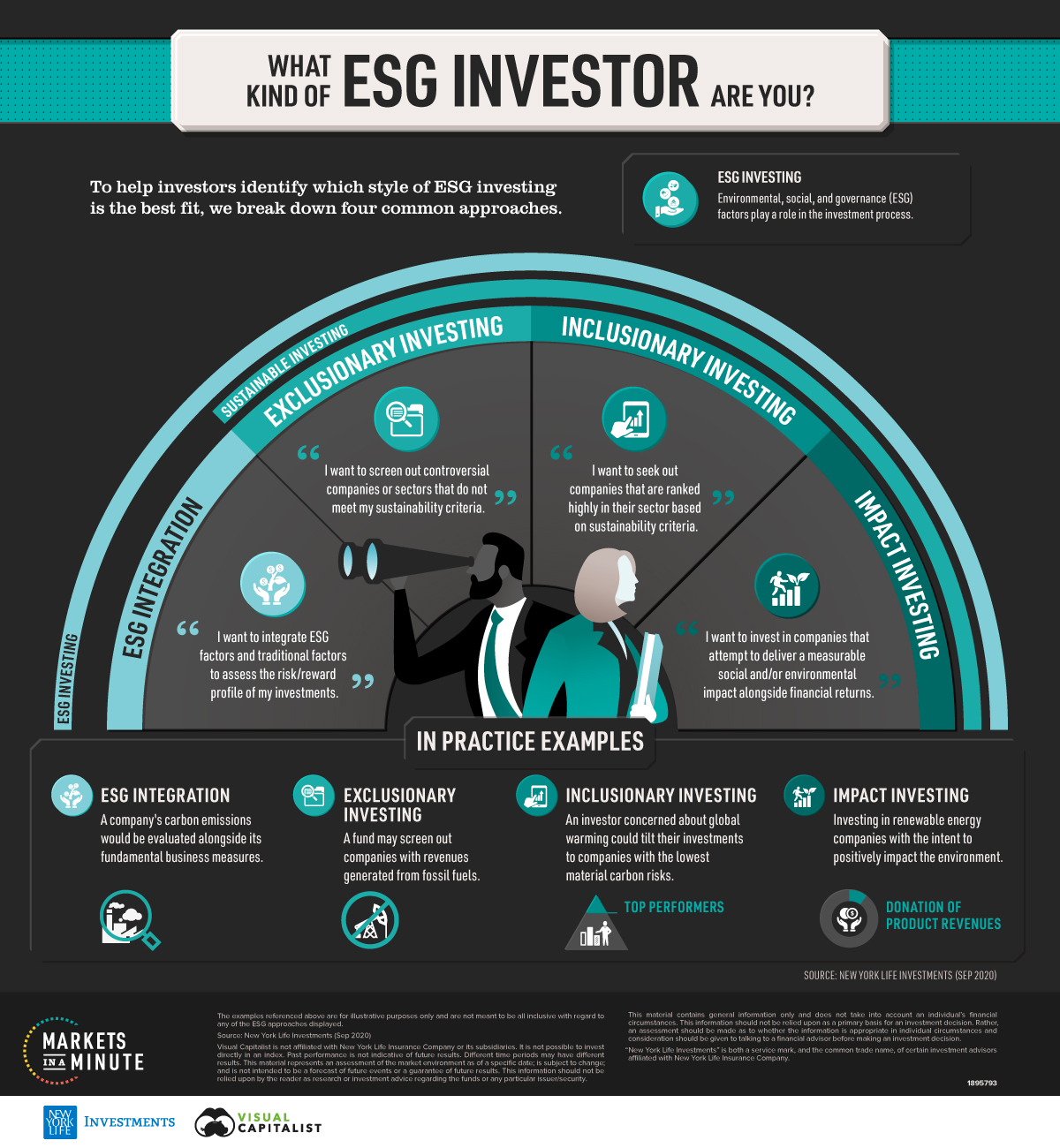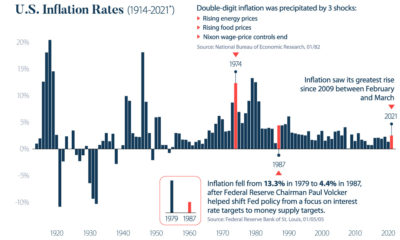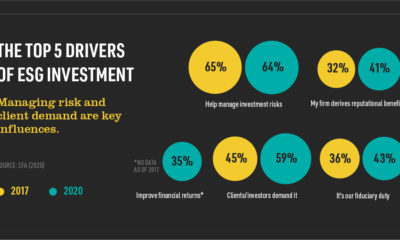This infographic is available as a poster.
Four Types of ESG Strategies for Investors
In recent years, sustainable investment strategies have shown a number of benefits for investors, from resilience in market downturns to share outperformance in the long-term.
Meanwhile, investor interest has skyrocketed—with environmental, social, and governance (ESG) indexes advancing 40% between 2019 and 2020 alone. Given the increased demand for green investments, investors have an ever-expanding list of options to choose from. But what ESG approach is the right fit for you?
To answer this question, this Markets in a Minute chart from New York Life Investments looks at the primary strategies used in ESG investing to help investors choose the approach that works best for their portfolio.
What Kind of Investor are You?
Broadly speaking, there are four main approaches to ESG investing: ESG integration, exclusionary investing, inclusionary investing, and impact investing.
1. ESG Integration
“I want to integrate ESG factors and traditional factors to assess the risk/reward profile of my investment.”
For example, using an ESG integration approach, a company’s water usage and toxic emissions would be assessed against financial factors to analyze any future risks or investment opportunities.
2. Exclusionary Investing
“I want to screen out controversial companies or sectors that do not meet my sustainability criteria.”
Using an exclusionary investing approach, an investor may screen out companies whose revenues are from tobacco, gambling, or fossil fuels.
Related ESG Terms:
- Negative Screening
- Negative Selection
- Socially Responsible Investing (SRI)
3. Inclusionary Investing
“I want to seek out companies that are ranked highly in their sector based on sustainability criteria.”
With an inclusionary approach, a fund may include the leading companies in a sector, relative to their peers, such as the top performing tech companies in ESG.
Related ESG Terms:
- Positive Screening
- Positive Selection
- Best-In-Class
- Positive Tilt
- Thematic Investing
4. Impact Investing
“I want to invest in companies that attempt to deliver a measurable social and/or environmental impact alongside financial returns.”
Lastly, impact investing approaches may focus specifically on renewable energy companies that have the intent to make a positive environmental impact.
Related ESG Terms:
- Goal-Based Investing
- Thematic Investing
ESG Investing Strategies, By Market
How does interest in ESG strategies vary according to geographical region? Overall, interest has increased across all regions globally (where data was available).
| Interest in ESG By Market* | 2018 | 2020 |
| India | 98% | 100% |
| Mainland China | 95% | 98% |
| UAE | 90% | 94% |
| Mexico | N/A | 92% |
| France | 79% | 91% |
| Brazil | 82% | 90% |
| Japan | N/A | 88% |
| Hong Kong, SAR China | 71% | 86% |
| South Africa | N/A | 83% |
| Germany | 64% | 81% |
| Singapore | 77% | 78% |
| United Kingdom | 51% | 77% |
| Canada | 49% | 68% |
| Australia | 49% | 65% |
| U.S. | 49% | 57% |
*With interest in these strategies and already employing them
Source: CFA Institute (Dec, 2020)
At the top was India, where 100% of respondents expressed interest or were already using ESG strategies—up from 96% in 2018.
In fact, India developed National Voluntary Guidelines on Social, Environmental, and Economic Responsibilities of Business as far back as 2011. This was designed as a guideline for responsible business conduct, which later aligned to the UN Sustainable Development Goals in 2016.
Following closely behind were investors in China (98%) and UAE (94%).
By contrast, 57% of investors in the U.S. employed ESG strategies—the lowest among geographic regions. Despite this, in the last two years, this figure jumped 8%, and it may rise higher yet given U.S. president Joe Biden’s new climate priorities. Electric grid and clean energy, decarbonization, and electric vehicle incentives all fall under a massive $2 trillion infrastructure plan, which will likely have a significant impact on the dialogue surrounding ESG.
Going Green
As the global drive for ESG investment continues to rise, investors can harness a greater understanding of different ESG strategies to meet their personal objectives—whether it is risk/reward analysis, seeking out ESG top performers, or a measurable environmental impact.




 Infographics2 years ago
Infographics2 years ago
 Markets in a Minute2 years ago
Markets in a Minute2 years ago
 Markets in a Minute2 years ago
Markets in a Minute2 years ago
 Infographics2 years ago
Infographics2 years ago
 Markets in a Minute1 year ago
Markets in a Minute1 year ago
 Infographics3 years ago
Infographics3 years ago
 Markets in a Minute2 years ago
Markets in a Minute2 years ago
 Infographics1 year ago
Infographics1 year ago




















